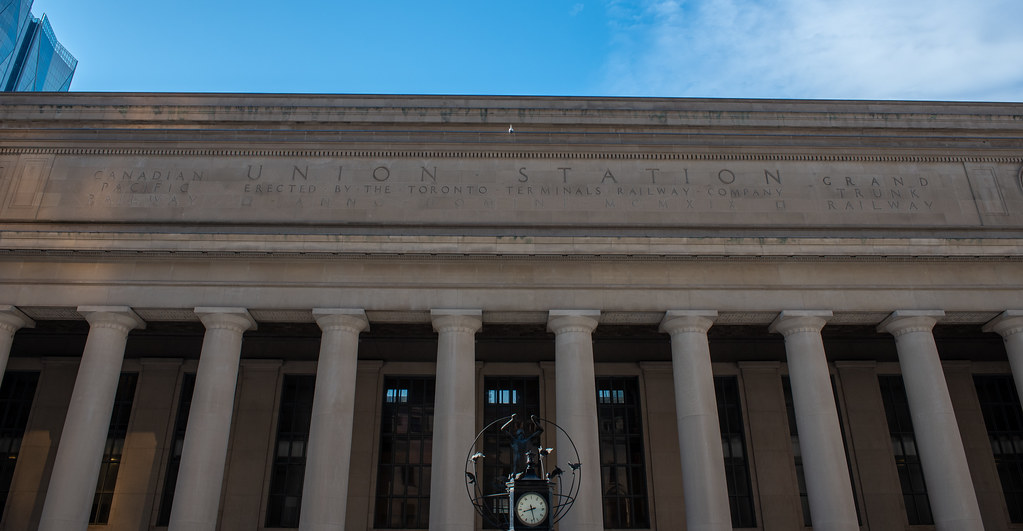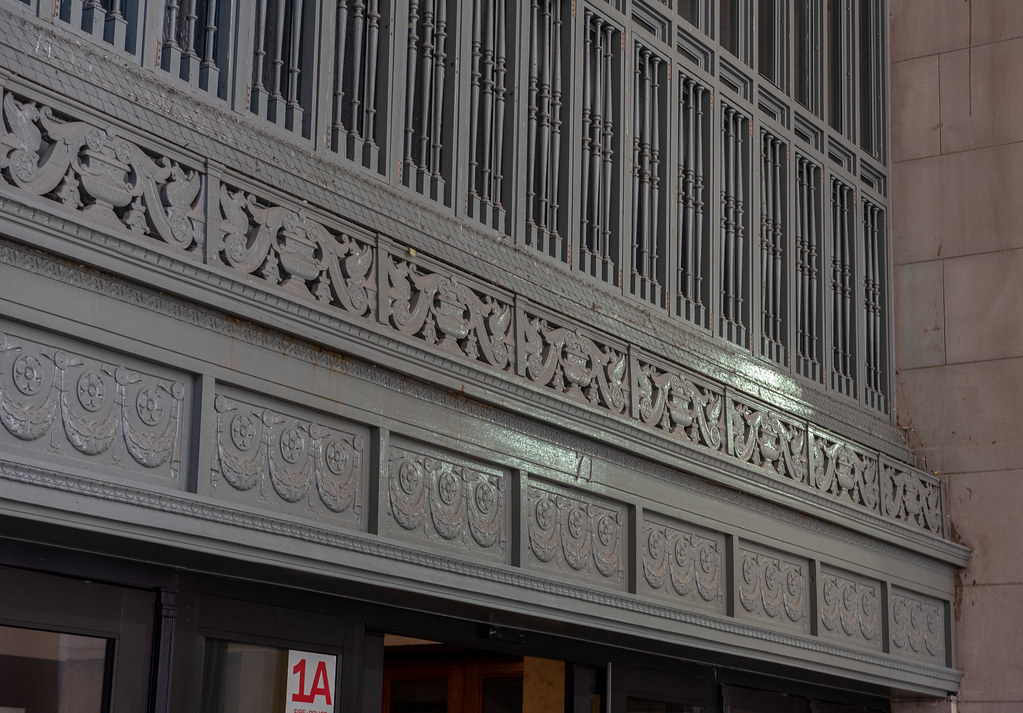And perhaps the most incredible reminder of the grandeur of rail travel during the golden age of rail in Canada. If you have ever travelled by rail into, out of or through Toronto, you have more than likely passed through Toronto’s Union Station. While the railways that operate out of Union Station have changed since its inception, it remains a proper Union station with five railways continuing to call at the city.

Graflex Crown Graphic – Fuji Fujinon-W 1:5.6/125 – Ilford HP5+ @ ASA-200 – Pyrocat-HD (1+1+100) 9:00 @ 20C
But the station we have today is the third Union Station in Toronto. But its location has been connected to the railway since the first years of the railroad in Ontario. The strip of land along Front Street has long anchored Ontario’s major railway operators. The first railway to run a train up from Front Street was Ontario, Simcoe & Huron, which in 1853 ran a line from the city to Aurora and on to Collingwood; Grand Trunk Railway and Great Western Railway followed. All three operators constructed their stations, and each operator had to share the same small footprint of real estate that became known as the rail lands. Grand Trunk came up with the idea of sharing a single station between the three operators. Opening in 1858, a group of three wooden shed-styled buildings took the name “New Station” all three operators started some platforms with each maintaining their staff and ticket windows. The New Station stood west of the current Union Station, between York and Lower Simcoe on Station Street. Station Street is still present today but is largely hidden from sight. But almost as soon as the New Station opened, it became clear that as the popularity of rail travel grew, the station could not support the number of passengers moving through each day. However, the station’s claim to fame is the arrival of delegates from the Charlottetown Conference in 1864, the first move towards the union of the Provinces of British North America. Rather than expand, both Great Western and Northern Railways constructed their new stations further away in 1866 and 1867, respectively. In 1871, Grand Trunk erected a small temporary station and demolished the New Station. Architect Thomas Seaton Scott designed the new station with E.P. Hanna as Chief Engineer and local firm John Shedden & Co hired as the contractors. The new station, designed in the Second Empire style, went up over the next two years, opening in a grand ceremony on 1 July 1873. The station stood south of the tracks, with the main entrance facing Toronto’s harbour facilities. Passengers were forced to wait outside for their trains and were often at odds with the elements. They crossed a bridge of sighs from the platforms into the central station. A grand concourse proved to be the anchor for the station. A high vaulted ceiling with a tiled floor, oak wood furniture and brass accents that quickly proved impossible clean—additionally, a family waiting room and a men’s smoking room. A small selection of commercial services was available in the station. The new station significantly impacted the city skyline with the main central tower and two smaller buildings at either end of the station.

Nikon D750 – AF-S Nikkor 28-70mm 1:2.8D
Nikon D750 – AF-S Nikkor 28-70mm 1:2.8D
The problem was that Grand Trunk spent the next decade further expanding its networks. Both Great Western and Northern Railway of Canada returned to the new Union Station and eventually swallowed Grand Trunk. Even Credit Valley Railway soon gained access to downtown and Union Station. The real problem came when in 1884, Canadian Pacific gained their foothold in Union Station. It soon became apparent that even the new station, though larger, would struggle to keep up as more people took the train. By 1890 the station handled sixty trains per day. Grand Trunk turned to architect Edmund Wagga to design an expansion in 1892. When it opened in 1896, it made the station worse rather than better. The addition clashed with the original station built in the Romanesque style of Queenston limestone and a seven-storey brick tower. It added only office space and more commercial space. But it made the station challenging to navigate. More platforms were added on the trackside, and a small shed was added to cover several of the platforms. An article on the station described the new Union Station as the most frustrating station in North America. While Grand Trunk rode high on profitability, they made no move to replace or improve Union Station. The 1904 fire that destroyed a great deal of downtown Toronto proved a blessing in disguise. While the rail lands and Union Station escaped destruction, a vast swath of land next to the station was wiped off the map. Grand Trunk and Canadian Pacific incorporated Toronto Terminal Railways, each operator holding 50% of the shares to construct a new Union Station. But infighting and disagreements over size, style, and form were only made worse by the city making itself heard. It wouldn’t be until Montreal firm Ross & MacDonald produced a suitable design and the city approved the track routing that shovels could get in the ground. By this point, the old Union station struggled to support the 40,000 daily passengers and 150 daily trains.

Nikon D750 – AF-S Nikkor 28-70mm 1:2.8D
Nikon D750 – AF-S Nikkor 28-70mm 1:2.8D
Construction started in 1914; the new Union Station would grow next to the old station, but with the frontage towards Front Street rather than the rapidly moving waterfront. Construction would not get far as materials and workers became scarce as the war in Europe escalated. Construction would not resume until 1920 and moved quickly. The grand opening of the still incomplete station on 6 August 1927 was attended by the Prince of Wales, the future King Edward VIII. The new station was constructed in the Beaux-Arts style using Queenston and Indiana Limestone mix, a large centre section, and two symmetrical wings to the east and west. The wings contained railway offices, a postal station, and freight and express offices. The main entrance featured a selection of Tuscan columns. Inside, passengers entered a grand four-storey concourse with a rich tiled ceiling, brass accents and stone walls. Lines of ticket booths could sell tickets to points across Canada and the United States. The station featured washrooms, several waiting rooms, and a small collection of commercial spaces. Construction would continue into 1928 when the old Union station finally closed, and demolition began almost immediately. An interesting side note, the clocks from the station ended up in Huntsville, Ontario, installed in the community’s town hall. The train shed would not see completion until 1931. The new Union Station could finally support the city’s needs with enough space for many passengers and trains moving through the city. The first significant change to Union Station came in 1954 when the Toronto Transit Commission opened a subway beneath Front Street and connected it to the train station. GO Transit took up residence at Union Station in 1967 as an anchor point for their new commuter service.

Nikon F5 – AF Nikkor 35mm 1:2D – Ultrafine Extreme 100 @ ASA-200 – Ilford Microphen (Stock) 9:00 @ 20C
Nikon F5 – AF Nikkor 35mm 1:2D – Ultrafine Extreme 100 @ ASA-200 – Ilford Microphen (Stock) 9:00 @ 20C
With passenger services starting to decline on the Canadian Pacific and Canadian National lines, the fate of Union Station seemed up in the air. Both operators were already selling off sections of the massive rail lands for condo developments starting in the 1970s. Even Union Station, like the rest of the city, was looking worse for wear, a layer of grime obscuring the limestone exterior. It seemed that by 1972 the plan to demolish Union Station was ready to go, replaced with a fourth Union Station or Metro Centre located entirely underground. When the project went public, the city looked at what happened a decade earlier in New York City with the demolition of Penn Station. Rather than see the same thing happen in Toronto, the railroads were blocked from enacting their plan. While the entire station would survive, a new underground element opened in 1975. The GO Concourse opened up a large area for passengers on the GO Train service and added a selection of food services for all those using the station. Although not even the Federal Government could save the passenger services on both operators and in 1978, VIA Rail took over the service leasing Union Station from Toronto Terminal Railways. The station’s owner remained under the control of Canadian Pacific and Canadian National. Through the last two decades of the 20th Century, some effort went into cleaning up Union Station, primarily exterior work. Inside, the station remained much the same, with almost every passenger-accessible space starting to look old. In 2000 the City of Toronto made the bold move and purchased the entire station from Toronto Terminal Railways. In 2003 the reason became clear: they intended to complete the ageing station’s restoration and revitalisation. Construction started in 2010; historical elements were cleaned and revitalised, including the entire front facade, the concourse and VIA waiting rooms were cleaned up and restored. The train shed received a new glass ceiling, improved lighting and a modern signal system. But the fundamental changes happened underground with a far larger GO Concourse and restoration of the original 1975 section. It resulted in more space for passengers and improved commercial and food services. While initially slated for a grand reopening in 2014, work lasted until 2021, when the final stages were done, and the new station is ready for its 100th anniversary in five years.